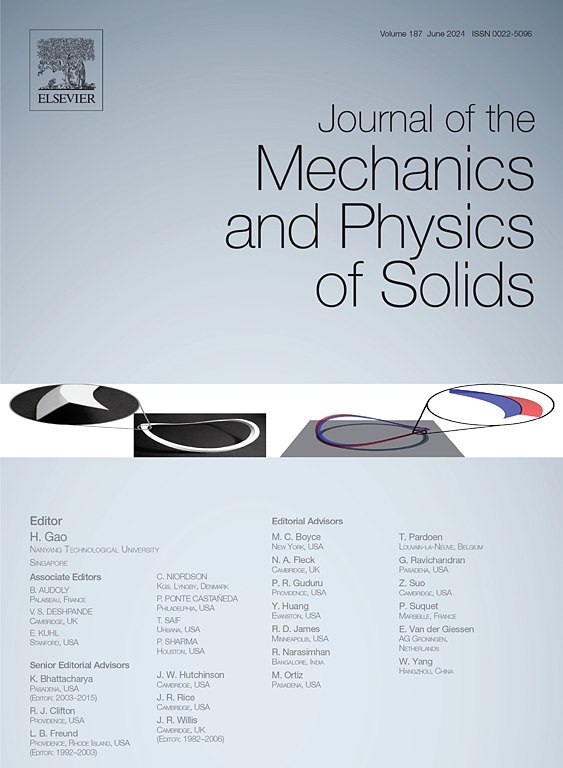Modeling the crack propagation of ductile fibril reinforced polymer membrane with the consideration of drawing fibrils
IF 5
2区 工程技术
Q2 MATERIALS SCIENCE, MULTIDISCIPLINARY
引用次数: 0
Abstract
Microfibril reinforced polymer composites (MFCs) are polymer-polymer composites with ductile fibrils embedded, usually increasing the tenacity of the polymer matrix. One of the successful applications is the expanded polytetrafluoroethylene (ePTFE) reinforced perfluorinated sulfonic acid (PFSA) membrane, in which the embedded ePTFE fibrils evolve into drawing fibril connecting crack surfaces, significantly increasing the fracture toughness of the membrane. Among the fracture modeling techniques, the virtual crack closure technique (VCCT) provides a thermodynamics-consistent explanation of crack propagation of the material, while the effect of drawing fibrils in the case is hard to be considered. The cohesive zone model (CZM) considers the gradual damage progress of the material at the crack tip through the traction-separation law, which is suitable for describing the evolution of drawing fibrils but the applicability of the empirical traction-separation laws to drawing fibrils remains uncertain. This paper establishes the constitutive and fracture models of the ePTFE reinforced PFSA membrane, and numerically realizes the fracture propagation of the microfibril reinforced material through the user subroutine of ABAQUS. For the constitutive modeling, an extended eight-chain model with the consideration of the fibril orientation is established to describe the deformation resistance of the fibril reinforcement. For the fracture modeling, a fracture criterion with the consideration of the negative work of the drawing fibrils at the crack tip is established, and numerically implemented through the extended VCCT. Uniaxial tensile tests and fracture tests of pure and various composite membranes are conducted, which verified the accuracy of the present model in describing the higher mechanical property and fracture tenacity of the composite materials. The model reveals the enhancement mechanism of the ductile fibril network and providing a new perspective of fracture modeling for ductile fibril reinforced polymer membranes.

考虑拉伸原纤维的延性纤维增强聚合物膜的裂纹扩展模型
微纤维增强聚合物复合材料(mfc)是一种嵌入韧性纤维的聚合物-聚合物复合材料,通常可以提高聚合物基体的韧性。其中一个成功的应用是膨胀聚四氟乙烯(ePTFE)增强全氟磺酸(PFSA)膜,其中嵌入的ePTFE原纤维演变成连接裂纹表面的拉伸纤维,显着提高了膜的断裂韧性。在断裂建模技术中,虚拟裂纹闭合技术(VCCT)为材料的裂纹扩展提供了热力学一致的解释,而在这种情况下拉伸原纤维的影响很难考虑。黏合区模型(CZM)通过牵引-分离规律考虑了材料在裂纹尖端的逐渐损伤过程,适合描述拉拔原纤维的演化过程,但经验牵引-分离规律对拉拔原纤维的适用性尚不确定。本文建立了ePTFE增强PFSA膜的本构模型和断裂模型,并通过ABAQUS用户子程序对微纤维增强材料的断裂扩展进行了数值模拟。在本构建模中,建立了考虑原纤维取向的扩展八链模型来描述原纤维钢筋的变形抗力。在断裂建模中,建立了考虑裂纹尖端拉伸原纤维负功的断裂准则,并通过扩展VCCT进行了数值实现。进行了纯复合膜和各种复合膜的单轴拉伸试验和断裂试验,验证了该模型在描述复合材料较高的力学性能和断裂强度方面的准确性。该模型揭示了延性纤维网络的增强机理,为延性纤维增强聚合物膜的断裂建模提供了新的视角。
本文章由计算机程序翻译,如有差异,请以英文原文为准。
求助全文
约1分钟内获得全文
求助全文
来源期刊
CiteScore
9.80
自引率
9.40%
发文量
276
审稿时长
52 days
期刊介绍:
The aim of Journal of The Mechanics and Physics of Solids is to publish research of the highest quality and of lasting significance on the mechanics of solids. The scope is broad, from fundamental concepts in mechanics to the analysis of novel phenomena and applications. Solids are interpreted broadly to include both hard and soft materials as well as natural and synthetic structures. The approach can be theoretical, experimental or computational.This research activity sits within engineering science and the allied areas of applied mathematics, materials science, bio-mechanics, applied physics, and geophysics.
The Journal was founded in 1952 by Rodney Hill, who was its Editor-in-Chief until 1968. The topics of interest to the Journal evolve with developments in the subject but its basic ethos remains the same: to publish research of the highest quality relating to the mechanics of solids. Thus, emphasis is placed on the development of fundamental concepts of mechanics and novel applications of these concepts based on theoretical, experimental or computational approaches, drawing upon the various branches of engineering science and the allied areas within applied mathematics, materials science, structural engineering, applied physics, and geophysics.
The main purpose of the Journal is to foster scientific understanding of the processes of deformation and mechanical failure of all solid materials, both technological and natural, and the connections between these processes and their underlying physical mechanisms. In this sense, the content of the Journal should reflect the current state of the discipline in analysis, experimental observation, and numerical simulation. In the interest of achieving this goal, authors are encouraged to consider the significance of their contributions for the field of mechanics and the implications of their results, in addition to describing the details of their work.

 求助内容:
求助内容: 应助结果提醒方式:
应助结果提醒方式:


